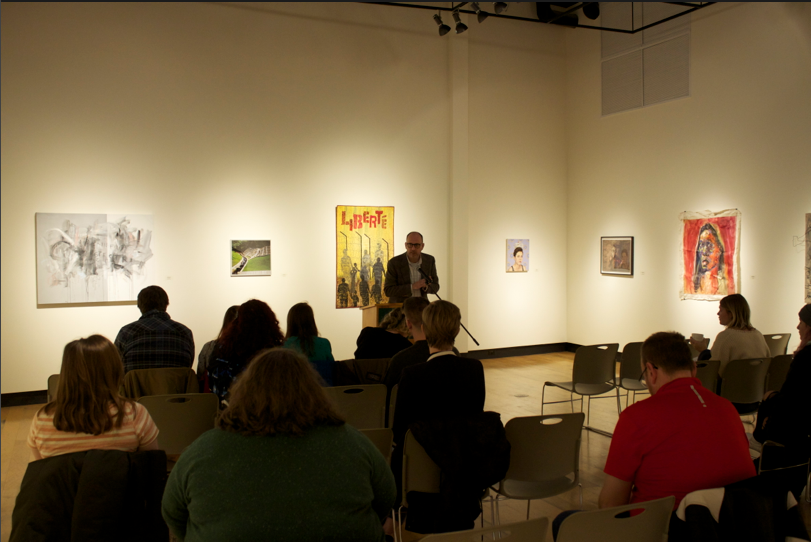NDSU creative writing students get the chance to read their work to an audience

Brady Bergensen an instructor for creative writing class introduced each student writer.
The Gallery in the Memorial Union was not only filled with the exhibit “Collective(in)Action,” but the voices of NDSU students reading their creative work on Thursday, Nov. 15.
Brady Bergeson, an NDSU instructor for creative writing and composition opened up the student reading by highlighting, “this is the first time that an event like this has taken place,” with the student’s (primarily creative writing students in their senior year) having the opportunity to read a variety of their chosen work and in the setting of the Memorial Union’s art gallery.
The readings showcased an array of different genres. Students read from their samplings of flash fiction, chapters from novels, poetry or short stories they’ve written. Readers in attendance were Leah Fisher who read two of her flash fiction pieces, ‘Wife’ and ‘Toaster,’ Noah Hansen read a chapter of his novel with the plot centering around a bank heist, along with the poem titled ‘I do not read,’ Grace Rivard read a short horror story titled ‘The Locals,’ Caleb Schafer started off with a joke and launched into powerful “prohibition speeches,” with ‘In this Climate,’ ‘The Light of the New Millennium,’ and ‘The Turkey’ and lastly, Erin Tamillo read a chapter from a novel she’s written.
Applause echoed throughout the art gallery at the finishing of the students’ readings. After walking over to the readers, I was able to ask them what creative writing means to them and why, in their own words, is it important. Erin Tamillo stated, “[by] growing up and being exposed to different genres and storylines in books,” she was able to channel that and write creatively. She also stated, “It’s an incredible way to get your feelings out and when you’re able to read in a space like this, a writer can better connect themselves to the audience.”
Creative writing can also be used as a way to creatively process things such as what Grace Rivard explains as, “The ability to exercise haunting images and thoughts in my head.” Being able to exercise these thoughts, “I’m able to further explore what it means.”
Caleb Schaffer highlighted that the poetry he created and in turn read, at the student reading was sparked by his Senior English Capstone on the “discussion of Patriotism and what that means.”
People slowly filed out and I was able to make my way to two of the creative writing instructors; Brady Bergeson and Ryan Christianson who were in attendance. They highlighted that this event was put on for students to have the ability to “share their work.” They also highlighted that the creative writing minor is new and, “Only started two years ago due to the fact we saw a compounding interest of students who were interested in different aspects of creative writing.” I then learned that there are currently (this semester) thirty students in the creative writing minor but, you don’t have to be striving toward a minor to take the courses.
In fact, ‘Introduction to Creative Writing’ and ‘Writing and the Creative Process’ are offered as an option to fill general education requirements at NDSU.
Creative writing isn’t just for English majors. Ryan Christianson states, “You can take a creative writing class without having the commitment of fulfilling a minor.” Some of the classes offered in the creative writing field at NDSU are Creative Nonfiction, Scriptwriting, Poetry, Introduction to Creative Writing, Writing and the Creative Process and Fiction.
Brady Bergeson highlighted the fact, “There are students from fifteen different majors taking a creative writing class right now,” showing that creative writing is for everyone. The creative writing instructors’ goals are to, “get students involved,” and in the end, “students will recognize the value of constructing a story.” This skill translates to other majors. An example of this is the telling of the story of a company. Ryan Christianson goes onto further say, “Storytelling is a part of our culture and can be used to influence people.”
Lastly, I asked, “What are some new developments in creative writing?” They both responded with the emergence of electronic publishing and the continuation of monthly online journals, “Self-publication and flash fiction/nonfiction are also relatively new.”
Overall, this event was held for students to showcase their work to the public. Creative writing instructors hope to continue this on to hold an event like this every semester and I personally hope they do, because it was a success.
